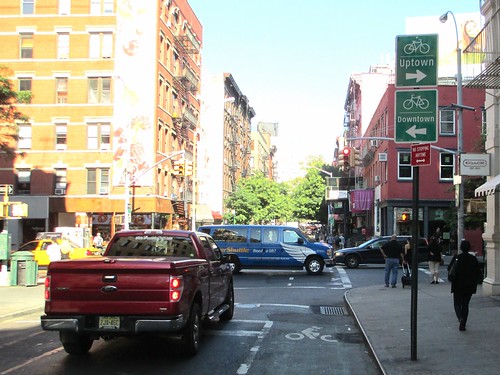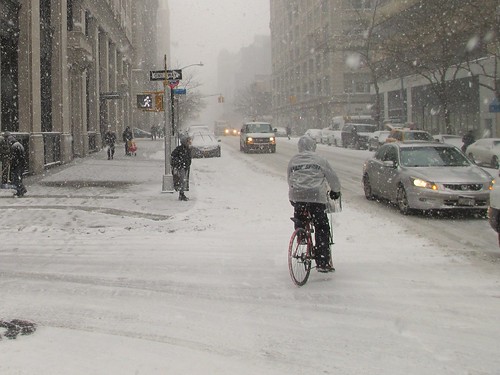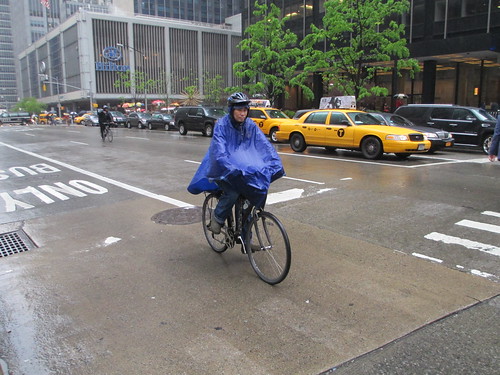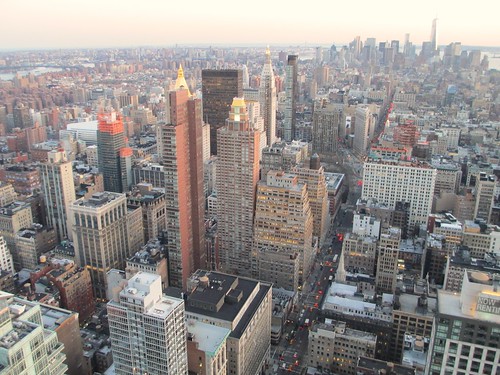The details of the time I was knocked off my bike in March
2009 remain vivid in my mind. The light telling me it was safe to ride across
Newington Causeway, near Elephant & Castle, South
London , was in my favour but had started flashing, to warn me it
would soon turn red. Being in a hurry and wanting not to lose momentum, I pedalled
out fast across the busy, four-lane road.
Then, as I reached the middle of the road, a rider on a fixed-wheel
bike came zipping past the line of stopped traffic, through the red light and
hard into my right-hand side. When I’d got up, out of the road, yelled at him
and told him I was calling the police, he made off.
Yet, while the facts are straightforward, I’ve had multiple
discussions since on how to interpret them. Several people have told me the
experience ought to make me acutely aware of the potential for rule-breaking
and negligent cyclists to cause serious injury to others. Some people become highly
agitated that I don’t accept such an apparently simple explanation.
It irritates some people still more that my interpretation
of the incident goes against the grain of my direct experience. I believe it demonstrates
how relatively safe bicycles are for other road users, even when ridden recklessly.
I was just recovering when I was struck on Newington Causeway from being
knocked off 32 days before by a negligent motorist. The collision with the reckless
cyclist hurt a lot less.
What happened to me was also fairly unusual. In many years
in the UK ,
cyclist/pedestrian crashes kill no-one – they are certainly a far lower share
of pedestrian fatalities than cyclists’ share of traffic. Despite two recent horrible tragic deaths after cyclist/pedestrian collisions in Central Park,
fatalities in cyclist/pedestrian collisions are just as rare in New York . The last such
death before the two recent ones was in 2009. I’ve never heard of a death from
a crash between two cyclists.
 |
| Prince St, SoHo, Manhattan: I see annoying cyclist behaviour here nearly daily - and reason tells me how little real significance it has. |
I stick to a more complicated interpretation because I’m
convinced it seldom makes sense to understand the world purely on the basis of
our own personal experience. It’s vital to overlay things one sees and hears
with information about their wider context. Careful, direct observation is certainly a useful way of enhancing our understanding of the world – but it’s a far
from complete one.
Most importantly, I’ve come to realise that people’s
reluctance to think rationally about events they’ve witnessed on the streets is
a significant barrier to improving safety. Serious crashes are so rare that
anyone basing their ideas about road safety purely on their own observations is
all but doomed to come up with a faulty understanding.
The phenomenon is at least in part responsible for the
terrifying taxi ride I had on Monday from my apartment to John F Kennedy Airport
It was clear to me from a rational understanding of the
risks of the driver’s speed, his limited room to correct if something went
wrong and knowledge of patterns of New
York road crashes that his behaviour was objectively
highly dangerous.
Yet the driver, who had presumably never crashed his vehicle
at speed into the expressway’s barriers, saw my complaint as an expression of
purely subjective taste.
“You’re scared?” he asked, with some amusement. “I’m fine.”
The root of such misunderstandings lies deep in unspoken
assumptions about how best to interpret the world. Many internet commenters and
others reflect without knowing it the ultimate triumph of Romanticism. Just as
Romantic poets like William Wordsworth thought emotion and experience the
critical means of interpreting the wider world, there’s a strong, implicit assumption
that one’s own subjective experience and one’s feelings about it are the only
reliable anchor for the ship of perception in the stormy, uncharted ocean of
reality.
 |
| A delivery cyclist heads the wrong way on Hudson St in a snow storm: an unspeakable, inexplicable menace - until you apply reason to it. |
It was because of this assumption that I found myself
lambasted this week in a debate on the New York Cycling Club’s Facebook page
about food delivery cyclists. Didn’t people agree, one member of the club had
asked, that food delivery cyclists needed to be properly regulated and banned
if they didn’t improve their behaviour? The conversation grew more and more
heated.
I pointed out, firstly, that food delivery cyclists are
already absurdly heavily regulated given the limited damage they cause. I added
that, since a collision with a food delivery cyclist last killed someone in
2009, they’re not as dangerous as they might seem. I suggested, lastly, that
it’s hardly surprising such a put-upon group – the delivery riders are nearly
all very poor, newly-arrived migrants – often feel too rushed to follow all the
road traffic laws.
The original poster’s furious response was to write that
she’d had to dodge six food delivery cyclists on her ride home that evening.
She so resented my effort to overlay an alternative interpretation that she
started questioning whether I really knew what was going on on the streets. Was
I even a cyclist? How many miles a year did I ride? It’s not the first time
I’ve been asked to provide an annual mileage as part of such a dispute (4,000,
since you’re asking). I eventually took the coward’s path of leaving the club’s
Facebook group to escape the bombardment.
 |
The Cateye bike computer I removed on
September 25 after 10 years' and 325 days'
use: 43,782 miles of evidence for doubters.
|
I find reason – the style of thinking in vogue just before
Romanticism – far more useful than Romanticism in interpreting the world. I’m
far more likely, it seems to me, to understand the world well if I seek to fit
my personal experiences into a broader framework of statistics, news reports
and other information. It’s because I try to view the world through such a coherent
prism that I seldom complain about the frequently irritating – but ultimately
not seriously dangerous – behaviour of pedestrians who obstruct me on my bike.
It’s because I can see from statistics that cars are much my biggest danger
that I far more regularly dwell on the risks they pose to my safety.
Nearly everyone who moans in newspaper comment pieces about
the dangers posed by reckless cyclists is doing so on a Romantic-Wordsworthian
basis. His or her experience of encountering cyclists – their fear at having a
rider pass close by or alarm at riders’ speed – is a reliable guide to how the
world works. A speeding cyclist dodging among pedestrians in a crosswalk looks
to the naked eye more dangerous than the surrounding, halted cars. Looked at rationally - including the vast amount of statistical evidence - the scene looks very different. It's clear the cars pose a far greater danger.
Reason, of course, is no policy-making vending machine. One doesn’t
put in a set of factors and collect a solution from a slot at the bottom. It
makes sense only in helping one to understand how to achieve a set of goals.
 |
| A delivery cyclist on Sixth Avenue: in need of still more harassment, according to one person with whom I argued. |
If, for example, one thought that the most important thing
on the streets was to impose a sense of order and fear of breaking the law,
possibly a further crackdown on food delivery cyclists might make sense. I look
at the issue within a wider framework of thinking police action must be
proportionate to the scale of the problem involved, that it’s better to have
goods carried around on bikes than in more dangerous cars and that it’s
important to feel compassion for society’s least powerful people. Reason is the
tool to help one to understand how best to achieve one’s objectives, not to set the objectives.
Yet “rational thinking, based on the fullest possible
information” is a poor slogan to paint on a battle standard. “Your personal
observations are deluding you” is likely to sound like an argument for a conspiracy
theory.
I’d consequently argue not just for pure reason but for the
outcomes it can produce. In many western countries – but especially the United States
– the current, Romantic means of making decisions is producing essentially
conservative outcomes. People don’t like the way they see cyclists riding their
bikes so argue against providing better facilities for them. People see drivers
parking their cars and going into shops, so conclude the shops will die if some
parking spaces move. People see traffic jams on streets that are broad and
conclude the jams will only get worse if the streets are narrowed to make bike
paths or wider sidewalks.
 |
| New York City: excitement and romance abound - but it would surely be better with the application of a bit more reason too. |
A more thoughtful approach can make powerful arguments for
changing things. A reasoned argument can point to the substantial evidence that
increased cycling can cut the US ’s
33,000 annual road deaths or the far smaller annual total in the UK . Reason can
point out that, while cyclists’ road deaths are visible, the risks of not
cycling – and of dying from diabetes, heart disease or an inactivity-related
cancer – are far higher. Logic can show that traffic often flows better in
narrower streets than wide ones.
Action based on those logical principles must ultimately
encourage more people to get about by bike, reduce road deaths and reduce pollution and carbon emissions.
That should mean that thousands more people daily can
experience the liberating feeling of powering themselves to work or school in
the open air, rather than inside a car or down in a subway tunnel. Far more people
will hear the sounds of birds chirping even in city trees, will spot the strange
effects of light at night and experience the change of seasons as one does on a
bicycle. Far more people will experience each morning the excitement of riding onto the Brooklyn Bridge and seeing Manhattan spread before them in the sunlight.
Those are all, reason tells me, positive changes, ones for
which sound, logical arguments can be made.
But they will provide plenty of moments to warm the heart of
a Romantic too.

As far as I can tell, and I continue my avid search, we lack reliable voices of Enlightenment values. For a long time, those values were the basis for me carrying on like some kind of apostle of reason, regenerate not through grace but through logic, reason, math, science, rational argument. I was wretched like Paul thinking about the flesh whenever I pondered unreason. My break with the popular apostles of that mindset came when I tried to take them at their word, yet found their rhetoric discordant with their message. Sam Harris in "The Moral Landscape," for example, claims so much, yet proves so little, utilizing debate tactics not much different from those of Fox News inside their teapot trying to build something monumental from so little actual material, making up the deficit with eristic. After closely reading that book, I went from ironically wretched to actually wretched. Next, I read Daniel Kahneman and ended up wandering in the desert on my mountain bike on a diet of locusts and energy gel. Short of some sort of actually benevolent and wise dictator philosopher king who straightens out our streets along rational and beneficial long-term view lines, I don't see much evidence or data to suggest that our odds of getting knocked off our bicycles by trucks again might become permanently lower due to policy or rational debate. If anything could help, it might be mass entertainments, aggressive marketing, movies, music videos, hiphop artists, who popularize cycling and expose its beauty and positive qualities to enough of an audience to move us toward more common and popular safe cycling. Those powerful forces currently seemed focused on expensive cars, hedonism, and terrible headphones, though, rather than on Safe Streets. I wish evidence and data moved people through their own logic toward a more sensible society. USA 2014 seems more or less antithetical to that notion though. I'm inspired by bottled water, though: if people will buy that, they'll pretty much buy anything, marketed effectively. That's a fact you can use for evil as well as good.
ReplyDeleteJRA,
DeleteThank you as ever for a wise - and beautifully put - comment.
You'll note I was careful not to suggest reason can solve all our problems. It can't tell us where we should be heading - it can merely tell us the shortest, simplest way to get there.
On the other hand, as you point out, the US these days is sufficiently antagonistic to reason that a new dose of it could do wonders for our common life.
All the best,
Invisible.
"...music videos..."
DeleteThis is one of my favorites:
https://www.youtube.com/watch?v=34FyWCutqvw
Such is typically the case with small, visible minorities. Perhaps when cycling becomes much more mainstream, we can all join in castigating those infernal blade skaters!
ReplyDeleteSteve A,
DeleteI'll admit I find blade skaters irritating - but I'm opposed in principle to getting too upset about them.
You're right that part of the issue is that cycling isn't a mainstream activity, but there are quite a few other issues in life in these United States where people favour Romantic thinking over Enlightenment. Might I point you, for example, towards thinking about guns, the second amendment to the constitution and the bizarre idea that a heavily-armed society is a more peaceful one?
All the best,
Invisible.
I believe that there was once a fatal bicycle-bicycle crash on the campus of Texas A&M University, but it was a decade or more ago and Google is not doing a good job of finding it for me. (But my memory on this sort of thing is generally accurate, at least so far).
ReplyDeleteThere’s a book, “Normal Accidents” by Charles Perrow that you might find interesting. It’s somewhat relevant to this in its discussion of systems so complex that accidents are “normal”, how social processes affect (and in some cases, effect) these accidents, in how we work to minimize their costs. The contrast between how we address maritime “accidents” and airline “accidents” is especially striking. Our treatment of cab drivers and delivery cyclists is somewhat like maritime law — in theory there are rules, but all the incentives are to bend or break them, and the rules only come into play when a crash occurs and it is necessary to find fault.
dr2chase,
DeleteThank you for your thoughtful comment - I'm glad I didn't accidentally delete this one as I did last time you tried to comment.
You're right that people struggle with the complexity of roads and that that's a huge part of why people are so bad at managing safety on them. Your point about maritime and airline accidents, meanwhile, is so acutely apposite that I wrote a post on this very subject (albeit about a rail accident, rather than a maritime or airline "accident") a few months ago: http://invisiblevisibleman.blogspot.com/2013/10/a-crash-on-brixton-road-backsliding-on.html
I'll keep an eye out for that book by Charles Perrow.
All the best,
Invisible.
As a London cyclist, pedestrian and driver I have never had a collided with a cyclist - however there have been three incidents as a driver and at least five as a pedestrian when I have been scared witless by a cyclist, and only avoided an accident because of my re-actions - in every case the cyclists just carried on their way!
ReplyDeleteI think the problem arises on both sides. Firstly there is a group of cyclists who want to get where they want to go as quickly as possible irrespective of anyone else on the road / footpath. The other road users are not "conditioned" to this form of behaviour and it catches them out when it happens. The same happens with speeding cars - as a pedestrian seeking to cross the road the brain will tell you that at an expeced (say) 30 mph there is plenty of time to cross, but the car is actually travelling at 45 mph ...
I would say it is more for the "rogue" cyclist to change behaviour rather than the rest of us to change our expectations.
Dear Anonymous,
DeleteThank you for your comment - but you've expressed exactly the kind of thinking I was criticising.
At least you've demonstrated that people do indeed think the way I suggested.
All the best,
Invisible.
That was a great post; I am big fan of all-too-absent application of reason to how we think about such things. I like to think I am well-reasoned in my discussions with others about cycling; in my experience it rarely goes over very well, whether I'm talking to motorists or cyclists. Each individual's personal experience seems to trump all other arguments. Just wanted you to know that you're not alone in wishing reason had a stronger role in current decision making.
ReplyDeleteCheck out this post
http://www.rantwick.com/2009/11/ive-got-question.html
In it I feel I ask some pretty reasonable questions. The comments section is the most interesting in the context of your article; my blog regulars seem to appreciate it while others go back to personal experience and begin questioning my qualifications to opine at all, just as you experienced on facebook.
Dear Robert,
ReplyDeleteThank you for another excellent piece of writing. Pierre Trudeau's motto "reason before passion" has become rather unpopular today.
As you correctly point out, this has the unfortunate result that people blow out of proportion minor risks that are "in their face," whilst ignoring serious dangers that pose a real threat of death or injury.
A good example of this is the Medical Officer of Health data that indicates that approximately 1,421 people in New York City are poisoned and killed by car and truck drivers every year. That is far more than the number that are crushed and killed by those people, yet which danger gets more publicity?
Kevin,
DeleteThank you, belatedly, for your continuing efforts to bring this issue to wider attention.
All the best,
Invisible.